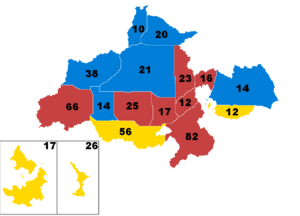2001 Soltenish Presidential Election
| |||||||||||||||||||||||||||||
469 votes up for election 235 votes needed to win | |||||||||||||||||||||||||||||
|---|---|---|---|---|---|---|---|---|---|---|---|---|---|---|---|---|---|---|---|---|---|---|---|---|---|---|---|---|---|
| Registered | 104,456,871 ( | ||||||||||||||||||||||||||||
| Turnout | 79,608,999 (76.2%) ( | ||||||||||||||||||||||||||||
| |||||||||||||||||||||||||||||
 Republics won by Girardino DaCareza
Republics won by Mario Boriello Republics won by Erik Schmidt | |||||||||||||||||||||||||||||
| |||||||||||||||||||||||||||||
The 2001 Soltenish presidential election was the 5th sexennial presidential election held in Soltenia. The election was held on Wednesday, July 11, 2007. Acting president Girardino DaCareza of the Republican Party, representing the United Left alliance, won a landslide victory against Confederal Union candidate and former premier of Orenza, Mario Boriello. DaCareza won by 10.6 points in the popular and vote and a landslide in the presidential vote, winning 335 votes to Schmidt's 134 and taking 10 of 17 republics. This election marked the first of three consecutive victories for the Leftist Alliance.
Stevenson emerged victorious on the third presidential ballot of the 1952 Democratic National Convention by defeating Tennessee Senator Estes Kefauver, Georgia Senator Richard Russell Jr., and other candidates. The Republican nomination was primarily contested by Eisenhower, a general who was widely popular for his leadership in World War II, and the conservative Ohio Senator Robert A. Taft. With the support of Thomas E. Dewey and other party leaders, Eisenhower narrowly prevailed over Taft at the 1952 Republican National Convention with Richard Nixon, a young senator from California, as his running mate. In the first televised presidential campaign, Eisenhower, in sharp contrast to Stevenson, was charismatic and very well known.[4]
Republicans attacked Truman's handling of the Korean War and the broader Cold War and alleged that Soviet spies had infiltrated the US government. Democrats faulted Eisenhower for failing to condemn Senators Joseph McCarthy, William E. Jenner, and other reactionary Republicans, who, they alleged, had engaged in reckless and unwarranted attacks. Stevenson tried to separate himself from the unpopular Truman administration but instead campaigned on the popularity of the New Deal and stoked fears of another Great Depression under a Republican administration.
Eisenhower retained his enormous popularity from the war, as was seen in his campaign slogan, "I Like Ike." Eisenhower's public support, coupled with the unpopularity of Truman, allowed him to win comfortably with 55.18% of the popular vote and carry every state outside of the South; he even managed to carry Virginia, Tennessee, Florida, and Texas, Southern states that had voted for Democrats since the end of Reconstruction, with the exception of 1928. Republicans made gains among Democrats, especially urban and suburban Southerners, and white ethnic groups in the Northeast and Midwest.
DaCareza ascended to the presidency when Olaf Berolder resigned in the wake of a vote-buying scandal, which badly damaged the Republican Party and its electoral prospects. Ford promised to continue Nixon's political agenda and govern as a moderate Republican, causing considerable backlash from the conservative wing of his party. This spurred former California governor Ronald Reagan to mount a significant challenge against him in the Republican primaries, in which Ford narrowly prevailed. Carter was unknown outside of his home state of Georgia at the start of the Democratic primaries, but he emerged as the front-runner after his victories in the first set of primaries. Campaigning as a political moderate within his own party and as a Washington outsider, Carter defeated numerous opponents to clinch the Democratic nomination.
Ford pursued a "Rose Garden strategy" in which he sought to portray himself as an experienced leader focused on fulfilling his role as chief executive.[2] On the other hand, Carter emphasized his status as a reformer who was "untainted" by Washington.[3] Saddled with a poor economy, the fall of South Vietnam, and the political fallout from the Watergate Scandal, including his unpopular pardon of Richard Nixon, Ford trailed by a wide margin in polls taken after Carter's formal nomination in July 1976. Ford's polling rebounded after a strong performance in the first presidential debate, and the race was close on election day.
Carter won a majority of the popular and electoral votes. He was able to carry several Midwestern and Northeastern swing states, as well as most states in the Democratic-dominated region of the South. Ford dominated the Western states. Carter's victory at the polls was due in part to the backlash against the Watergate scandal that still was deeply hurting Republican candidates. Ford became the only vice-president to become president and subsequently fail to win election for a term in his own right.

